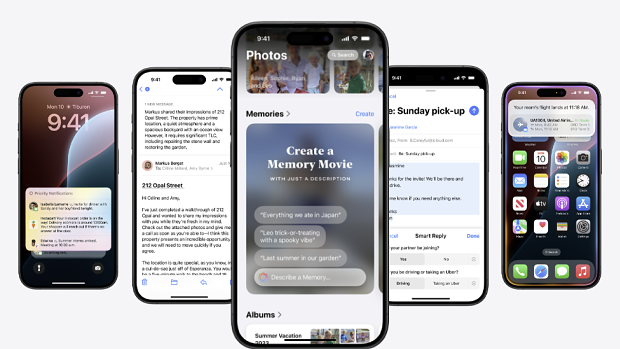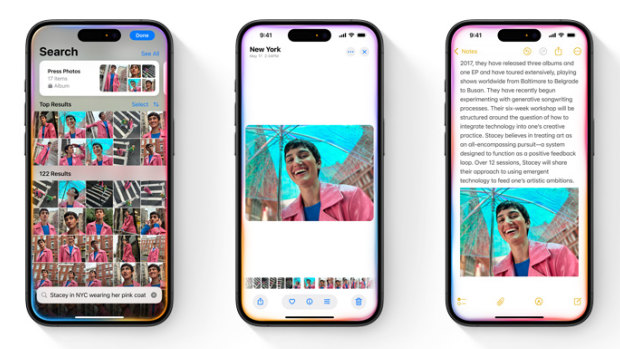- Analysis
- Technology
- Phones
Why iPhone 16 could be Apple’s biggest leap since Siri
By Tim Biggs
When Apple integrated the Siri digital assistant into its iPhone 4s 13 years ago, it was hailed as a new era for smartphones. Of course, it was a funny novelty as much as it was a genuine help in those early days, but Siri did end up popularising speech as a way to control your devices.
Yet over the next few years, it was thoroughly overtaken in capability by Google Assistant and Amazon’s Alexa.
Now, with many devices being upgraded with generative AI chatbots, Apple is preparing to catch up. When it unveils its iPhone 16 next week, it will do so in the context of a leap in its natural language interface the likes of which we haven’t seen since 2011. Here’s what you can expect.

Apple Intelligence will be integrated throughout iOS 18 on the new iPhone, as well as on last year’s iPhone 15 Pro.
All about Apple AI
Apple has set a date of September 9 (or early September 10, AEST) for its annual iPhone reveal event, with the invitation this time featuring the teaser text “it’s glowtime”. That potentially is an indication that Siri and Apple Intelligence could be more a focus of the event even than the iPhone 16 itself, given the voice assistant will have a new glowing visual effect when summoned in iOS 18.
We got a first look at Apple Intelligence when it was revealed at the Worldwide Developer Conference earlier this year, but expect next week’s event to go for a hard sell on why the software matters for iPhone in particular. If rumours are true, the intelligence features won’t all be present in iOS 18 on the day the iPhone 16 launches, and will instead be rolled out over the following weeks and months, so Apple will want to set a road map and encourage buyers to get in on the ground floor.
AI features Apple has announced for the iPhone so far
Writing tools, which can proofread your writing, rewrite messages for you in a different tone, or summarise long blocks of text from the web or messaging apps.
Priority notifications, which put the most important alerts at the top of your stack of notifications, using AI to summarise messages in short sentences.
Image generation using text prompts, including creating new emojis by describing them, and a wand that lets you circle rough sketches to generate images.
Search for content in Photos, or create a custom memory movie, by describing the pictures. Remove unwanted elements in your photos with a new clean up tool.
- Record, transcribe, and summarise spoken conversations, including directly from the phone app.
As for Siri, the redesigned assistant can invoke Apple Intelligence features on your behalf or dive into your “personal context” (meaning the data about you on your phone, from text messages to documents) to answer queries you type to it or speak out loud. Apple says it will remove the need to jump through multiple apps to find information, for example you can ask Siri to recall your passport number from a photo you took earlier when you need it to fill in a form, or you can ask about books your friend recommended to you, even if you can’t remember when or where they sent the list.
Most of Apple’s new AI features run on small models that are local to the iPhone, meaning they don’t need an internet connection and none of the data leaves your device. However, some requests will tap into Apple’s more powerful cloud servers, and the company has also partnered with OpenAI to use its massive ChatGPT models.
When the phone wants to use ChatGPT (Apple has given examples including generating text from scratch, or asking specific questions about the content of a document) it will ask first, and Apple says OpenAI will not keep your information.

The revamped Siri will be able to find a picture in your library, punch up the colours, attach it to a document and send it to a contact.
So what does all this mean for the iPhone?
Expect Apple to couch it in terms similar to when it integrated Siri into the iPhone 4s: this will save you time and make your everyday interactions with your device easier, more pleasant and more powerful, without sacrificing your privacy. But there are thornier implications too.
Generative AI still has very real problems. Chatbots designed to collect or summarise factual information routinely (if infrequently) seem to entirely invent details and present them convincingly. Even something as simple as a quick summary of an email can’t be entirely relied upon for any important purpose. Apple avoids some of this by passing complex text processes to OpenAI, but it will still need to work to explain how its features can be both useful and imperfect.
Image generation has its issues too, both in terms of creating meaningless nonsense and in creating convincing and dangerously misleading pictures. Apple appears to only allow the creation of cartoony images so far, and it may seek to differentiate itself from Google and Samsung by rejecting the idea that iPhone will ever allow photo-realistic tampering, despite its own photo clean-up tool.
What else to expect
Of course the entire event won’t hinge on AI alone; as usual, Apple will have a range of new hardware to detail, starting with the iPhones.
All iPhone 16 models are expected to have new chips and more memory to handle the increased demands of the AI features. Rumours indicate four models of iPhone 16, at four different sizes, with the Pro being larger than the standard model and the Pro Max being larger than the Plus. All four models are expected to get the Action Button that debuted on last year’s Pro phone, as well as a new Capture Button for taking landscape photos.
Apple is also expected to mark the 10th anniversary of the introduction of the Apple Watch with a significantly redesigned device, much like it did for the iPhone X in 2017. Rumours indicate the new wearable will be thinner, and some have suggested a new magnetic band attachment that would make the device incompatible with previous bands.
For AirPods, the rumours are that Apple is preparing two models of fourth-generation non-Pro buds, one that will include noise cancellation and one that won’t. It’s also said to have tweaked the over-ear AirPods Max to replace the Lightning port with USB-C.
Elsewhere, reports have indicated a number of future Apple devices that could potentially show up next week, though that’s far from guaranteed. This includes new iMacs, MacBook Pros and Mac Minis, a new standard iPad and iPad Mini, a new HomePod with a touchscreen, and even a smart display on a motorised stand that can turn to always be facing you.
Get news and reviews on technology, gadgets and gaming in our Technology newsletter every Friday. Sign up here.